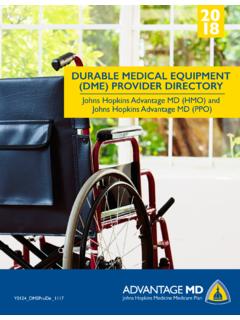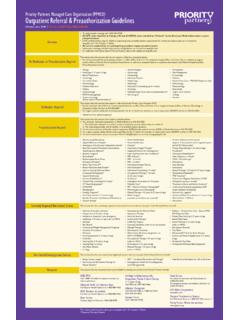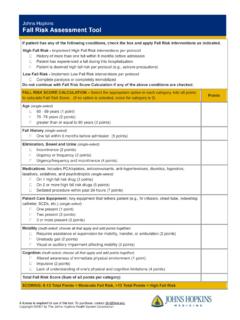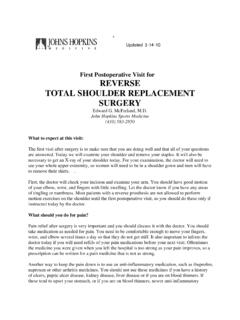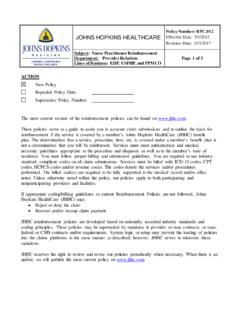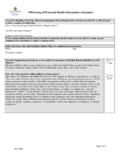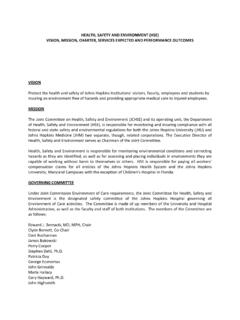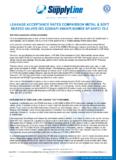Transcription of Patient Education - Hopkins Medicine
1 Johns Hopkins Hip and Knee Replacement ProgramPatient Education :Hip Replacement SurgeryWhat is Arthritis? Why Does My Hip Hurt?Your hip joint works like a ball and socket, with the upper portion of your femur (thigh bone) as the ball portion and your pelvis (hip bone) as the socket. In the hip joint, there is a layer of smooth cartilage on the upper end of the femur and in the socket of the pelvis. This cartilage serves as a cushion and allows for smooth motion of the hip. Arthritis occurs when the smooth cartilage wears away. The hip can then become stiff, swollen and painful. Eventually, the cartilage can wear down to the bone and the bones can rub against one another, causing more painWhat is a Total Hip Replacement?A total hip replacement is when the top part of the femur and the socket part of the pelvis is replaced. This is done by placing metal alloy on the top of the femur and in the socket part of the pelvis.
2 A smooth piece of cup-shaped plastic is inserted between this new ball and socket, which allows the ball to move smoothly. Replacement of the worn cartilage with the metal and plastic implant creates a new smooth cushion and a functioning joint. Although not a normal hip, a replaced hip provides significant relief from arthritis pain. Most patients have a marked decrease in their pain with substantial improvement in function, which allows them to remain active and enjoy activities that had been limited because of Hopkins Hip andKnee Replacement ProgramThank you for choosing Johns Hopkins for your hip replacement surgery. We use a team-based approach, and you are the most important person on this team!The Johns Hopkins Hip and Knee Replacement Program is dedicated to the care of patients undergoing hip and knee replacements.
3 patients are admitted on the day of surgery and are usually discharged on the first or second post-operative Hopkins Hip and Knee Replacement ProgramWhat are the Major Risks?There are known risks to having hip replacement surgery. Infection and blood clots are two serious complications that concern us the most. To lower your risk of infection, we ask you to wash before surgery with special cloths. We routinely use antibiotics in the operating room. To help protect you from blood clots, we use a blood thinner most commonly aspirin after with all orthopaedic surgery, there is the risk of nerve or blood-vessel injury, as well as fracture. Additionally, the implants that are placed can become loose from the bone or the plastic can wear away over time. Your surgeon will review these risks with you in greater Type of Anesthesia will I Have?
4 Different types of anesthesia are possible for your surgery. Your surgeon and anesthesiologist will discuss your options with you before your factors will be considered, including: Past experience with surgery Health and physical condition Reactions or allergies you have to medicines Risks of each type of anesthesia Preferences of your surgical teamWe prefer spinal anesthesia for most of our patients undergoing total joint replacement surgery. Spinal anesthesia numbs you below the waist and helps you wake up quickly, resulting in less risk of nausea than general anesthesia. We also will give you sedation so you are comfortable during the a CoachPlease select someone who will help you through your joint replacement process, your coach. This person can be a family member or good friend someone you can count on to be there to help you.
5 Your coach will go to therapy sessions while you are in the hospital and be present during your discharge Education . It is great to have someone who will support you during this Hopkins Hip and Knee Replacement ProgramJoint Replacement ClassWe offer a very informative class to help you and your coach prepare for your upcoming surgery. This class reviews important aspects of your care and what to expect during and after your hospital stay. You will meet many of the staff who will be caring for you during your stay and have a chance to have all of your questions answered. Please call 410-550-4972 to Long will I be in the Hospital?Many of our patients who have a total hip replacement go home as early as the next day; some may stay as long as 2 days. You will have physical therapy beginning on the day of your surgery, which will help your care team decide when you can safely be discharged.
6 Most patients are discharged with home or outpatient physical therapy. A few patients need inpatient therapy at discharge. Our care management team will work with you and your insurance provider to arrange this Hopkins Hip and Knee Replacement ProgramThe following section is a timeline to help guide you and your coach as your surgery date gets closer. We want to ensure that the weeks before your total joint replacement go Weeks before SurgeryMedical and Anesthesia ClearanceYou must be seen by your primary doctor, one of our medical doctors or in our Pre-operative Evaluation Center (PEC) within 30 days of surgery to determine if you are medically ready to have hip replacement surgery. patients who have certain medical conditions also may need to be seen by a specialist before their surgery. For instance, the primary care doctor may refer you to a cardi-ologist if you have a history of heart disease.
7 The anesthesiologist also will review your medical information to clear you for anesthesia during surgery. If you have any infection (urinary, skin, sinusitis, etc.), these will need to be treated before surgery. You must be off antibiotics for 2 full weeks before TestsYour primary care doctor and your surgeon may order specific lab tests before surgery. If the lab results are not received in a timely manner, it could result in a delay of your surgery. Johns Hopkins Hip and Knee Replacement ProgramJoint Effort ClassIf you have not already attended, please call 410-550-4972 to find out dates for the discussed in the class include: What to expect the day of surgery What to expect during your hospital stay Pain management after surgery Equipment used after surgery Overview of nursing care Overview of physical and occupational therapy Overview of discharge planning for home or rehabilitation facilityInsurance BenefitsUnderstand your insurance benefits so that you know what will be covered after surgery, including: Pain Medicine Home therapy or nursing Rehabilitation stay, if needed Physical therapy identify a physical therapy location close to your home that you can go to after surgery.
8 Make sure that this facility accepts your Hopkins Hip and Knee Replacement ProgramShort Arc QuadPlace a rolled up towel or object under your knee and slowly straighten your knee as you raise up your foot. Keep the back of your leg on the rolled up towel or object. Hold for 3 seconds. Return to starting position and ShellsWhile lying on your side with your knees bent, draw up the top knee while keepingcontact of your feet. Do not let your pelvis roll back during the lifting Learn post-operative exercises, illustrated below. Practice your foot and ankle pumps and straight-leg raises. Exercise 3 times per day until your surgery. Strengthen your legs and arms with water exercises that you can Hopkins Hip and Knee Replacement ProgramHeel Slides - SupineLying on your back with knees straight, slide the affected heel towards your buttock as you bend your knee.
9 Hold a gentle stretch in this position and then return to original Arc Quad - Low SeatWhile seated with your knee in a bent position and your heel touching the ground, slowly straighten your knee as you raise your foot upwards as shown. Lower your foot back down until your heel touches the ground, bending your knee as much as possible. Hopkins Hip and Knee Replacement ProgramSeated Heel SlidesWhile in a seated position with your foot forward and rested on the floor, slowly slide your foot (surgery side) closer toward you. Hold a gentle stretch for 10 seconds, and then return foot forward to original Heel RaisesWhile standing, raise up on your toes as you lift your heels off the Hopkins Hip and Knee Replacement ProgramStanding Hamstring CurlsWhile standing, bend your knee so that your heel moves towards your standing with feet shoulder-width apart and in front of a stable support for balance, bend your knees and lower your body toward the floor.
10 (Note: Your body weight should be directed through the heels of your feet. Knees should bend in line with the second toe and not pass the front of the foot.) Return to a standing Hopkins Hip and Knee Replacement ProgramStanding MarchingWhile standing, draw up your knee. Set it down and then alternate to your other side. Use your arms for Abduction - StandingWhile standing, raise your leg out to the side. Keep your knee straight and point your toes forward the entire time. Use your arms for balance and Hopkins Hip and Knee Replacement ProgramDental RequirementsHealthy teeth are important to prevent an infection in your new joint replacement. If you have not had a dental examination in the last year, schedule one before your surgery and tell your dentist that you are having a total hip replacement. If you have any dental issues, they must be treated before HabitsIf you are a smoker, stop smoking at least 6 weeks before surgery to reduce the risk of infec-tion.
